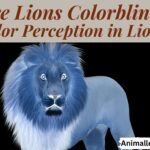Are Coyotes Colorblind? Understanding Coyote Vision
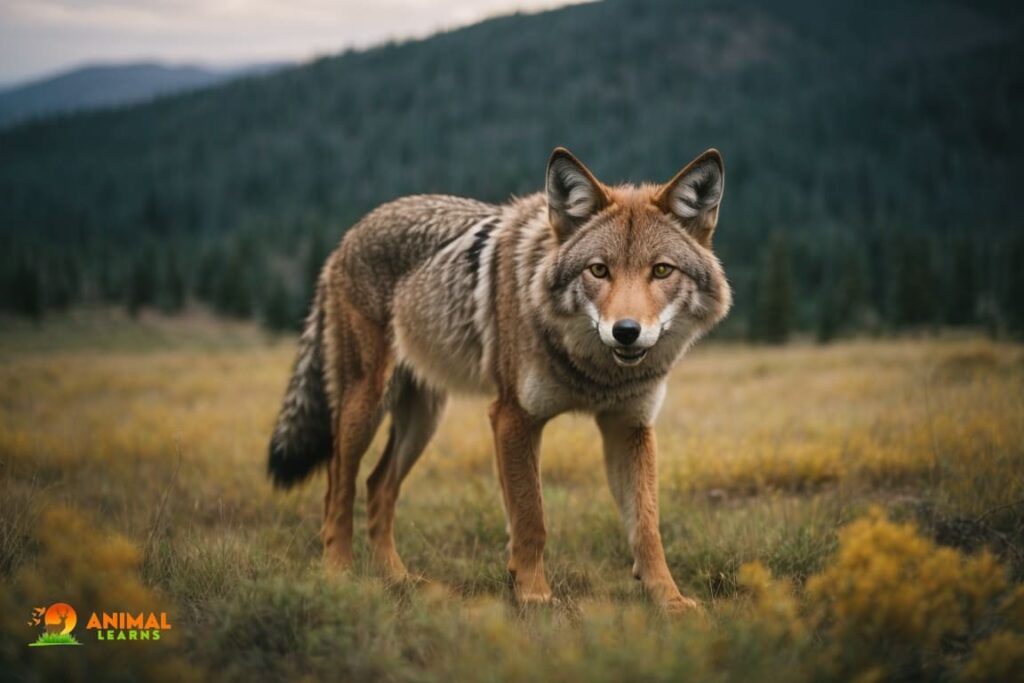
| Attribute | Information |
| Scientific Name | Canis latrans |
| Common Name | Coyote |
| Habitat | Varied, including forests, grasslands, and urban areas |
| Diet | Omnivorous, primarily small mammals, birds, and vegetation |
| Activity Pattern | Nocturnal, primarily active at night |
| Vision | Dichromatic (limited color vision) |
| Rod Cells | Abundant, specialized for low-light vision |
| Color Perception | Limited color vision; difficulty distinguishing reds and oranges |
| Night Vision | Excellent, due to rod cells |
| Social Behavior | Solitary or in small family groups |
| Territories | Defend territories, adaptable to different environments |
Are Coyotes Colorblind? Although it’s unclear exactly what animals can see, we do know that K9s can see some color. K9s see a narrower color range than humans, according to studies. Numerous studies have shown that coyotes only sense the yellow and blue color spectrum, whereas humans perceive a wide variety of colors in the environment.
In this article, we’ll delve into the fascinating world of coyote vision, addressing common questions and misconceptions.
Understanding Coyote Vision
Contents
- 1 Understanding Coyote Vision
- 2 Are Coyotes Colorblind?
- 3 Why is Red Light Great for Hunting Coyotes?
- 4 What Colors Can Coyotes See?
- 5 What Colors Are Coyotes Afraid Of?
- 6 What Colors Do Coyotes Not Like?
- 7 Can Coyotes See Color in Artificial Light?
- 8 What Does Coyote Vision Look Like?
- 9 Coyote Night Vision: How Well Can They See in the Dark?
- 10 Coyote Photoreceptors
- 11 Conclusion
- 12 FAQs
To understand how coyotes perceive color, it’s essential to delve into the intricacies of their visual system. Coyotes, like most mammals, have eyes that are adapted to their ecological niche, which primarily involves being crepuscular or nocturnal hunters. Let’s break down the key aspects of coyote vision:
Coyote Color Vision: What Can They See?
Imagine the world through a coyote’s eyes, and you’ll get a picture of a landscape with muted colors. Their vision is not as vibrant as human vision, but it’s highly attuned to motion and contrast.
Coyotes have a unique visual system that enables them to navigate their world effectively, especially during their nocturnal adventures.
While they are not colorblind, their color vision is limited. Coyotes can see colors such as blue, violet, green, and yellow, but they struggle to differentiate between red and orange.
These warm colors appear as shades of gray or brown to them. This limited color vision is adapted to their natural habitat and hunting behaviors, allowing them to excel in their role as crepuscular and nocturnal hunters.
Visual Acuity
Coyotes possess relatively sharp visual acuity, allowing them to detect fine details in their surroundings. Their eyes are positioned in the front of their skull, providing them with binocular vision, which aids in depth perception and judging distances accurately.
This binocular vision is especially beneficial when stalking prey or navigating through challenging terrain.
Are Coyotes Colorblind?
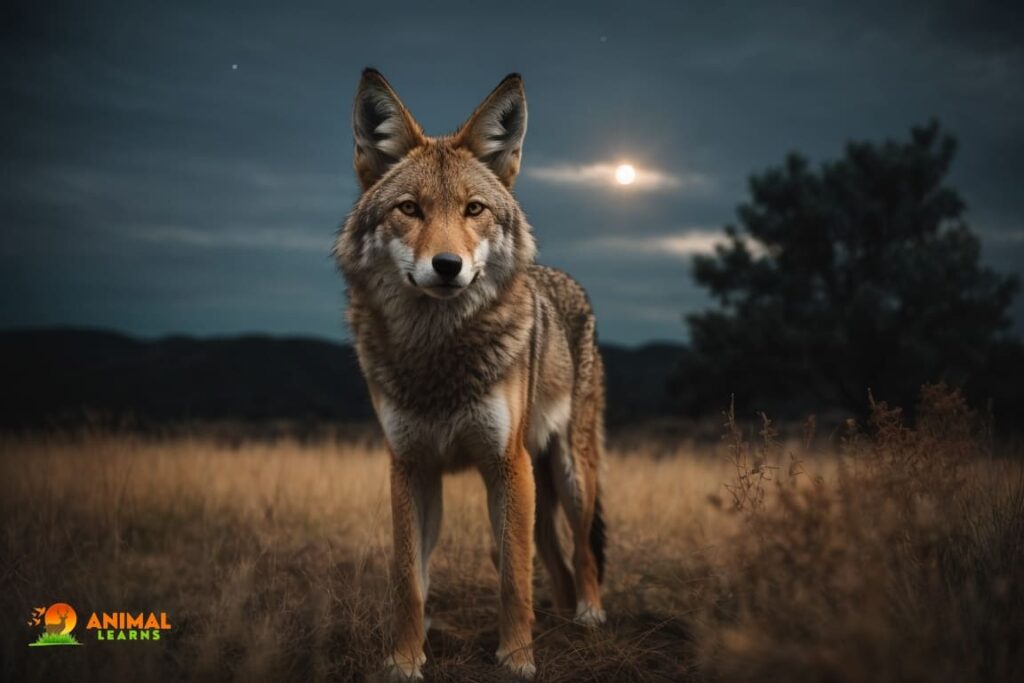
Coyotes are not completely colorblind, but their color vision is limited compared to humans. Like many other canids, they are dichromatic, meaning they have two types of color receptors, or cones, in their eyes.
These cones are sensitive to short wavelengths (blue and violet) and middle wavelengths (green and yellow) of light. However, they lack cones sensitive to long wavelengths (red and orange).
Can Coyotes See in the Dark?
Coyotes are renowned for their nocturnal habits, and their vision is well-suited to low-light conditions. While they can’t see in complete darkness, they have excellent night vision compared to humans.
Their eyes are equipped with a high number of rod cells, specialized for low-light vision, which allows them to see well during twilight and under moonlit skies. This adaptation makes them proficient hunters during the night.
Eye Color in the Dark

Are coyotes colorblind? Many people wonder about the visual abilities of these elusive creatures. While it’s fascinating to explore what coyotes can see, it’s also interesting to consider their eye color in different lighting conditions.
Coyotes typically have amber-colored eyes that may appear to glow in the dark when illuminated by artificial light sources. This glowing effect is due to the tapetum lucidum, a reflective layer behind the retina that enhances their night vision by reflecting light back through the retina.
The tapetum lucidum enhances their ability to see in low-light conditions, giving their eyes a distinctive appearance in the dark.
Why is Red Light Great for Hunting Coyotes?
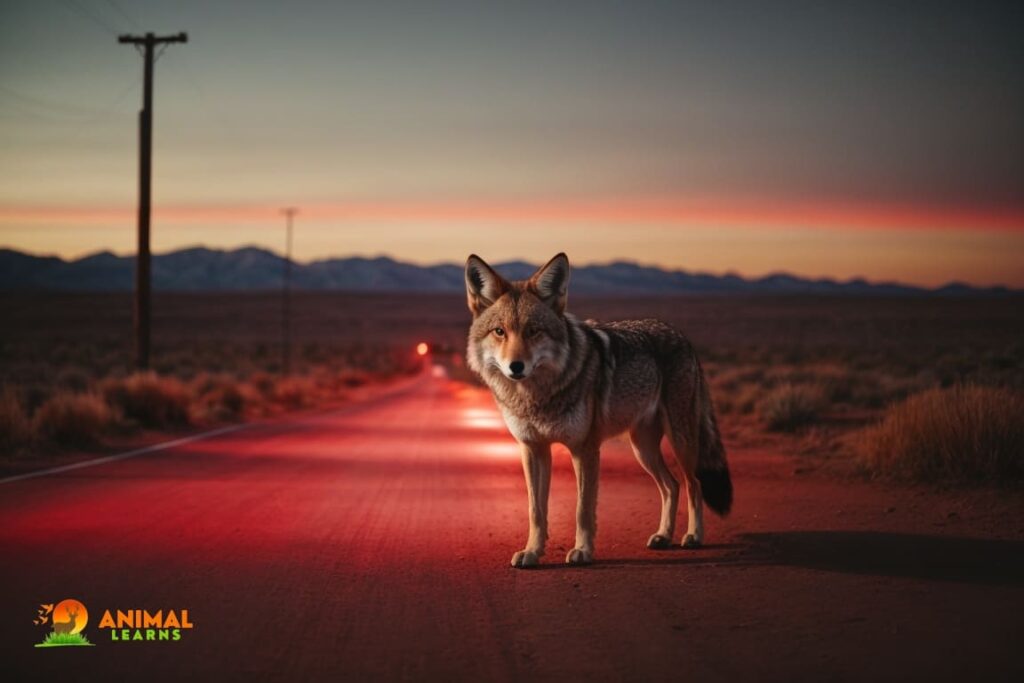
Coyotes have a unique vision that makes them less sensitive to red light. This makes red light highly effective for hunting coyotes, as it minimizes the risk of alerting or spooking them.
Red light sources are perceived as less intrusive by coyotes, allowing hunters to maintain better visibility in the dark while reducing the likelihood of disturbing their elusive quarry.
So, if you’re planning a coyote hunting trip, make sure to pack a red light source to increase your chances of success!
Can Coyotes See Red Light?
Are coyotes colorblind? Many people wonder about the visual abilities of these elusive creatures. Coyotes are fascinating creatures, but did you know that they have a limited ability to see the color red?
Their vision is primarily composed of two types of photoreceptor cells that are sensitive to blue and green light, which makes them dichromats.
This means that they struggle to distinguish between red and other colors, perceiving red as a less distinct hue. As a result, coyotes do not see red light as vividly as other colors, and it may appear less noticeable to them in their environment. This is an interesting fact about coyotes that many people may not know.
Can Coyotes See Orange Light?
Coyotes have difficulty distinguishing between reds and oranges due to their limited color vision. In the orange part of the spectrum, their vision may be somewhat compromised.
However, it’s important to note that coyotes rely on various senses, such as smell and hearing, in addition to vision when hunting or navigating their environment.
What Colors Can Coyotes See?
In the realm of animal vision, the question that often arises is, “Are coyotes colorblind? Coyotes’ limited color vision means they perceive the world in a more muted palette than humans.
They can see shades of blue, violet, green, and yellow, but they cannot distinguish between red and orange. To a coyote, red and orange objects would appear as shades of gray or brown.
This color perception is adapted to their natural environment, where these muted shades are sufficient for their survival and hunting needs.
What Colors Are Coyotes Afraid Of?
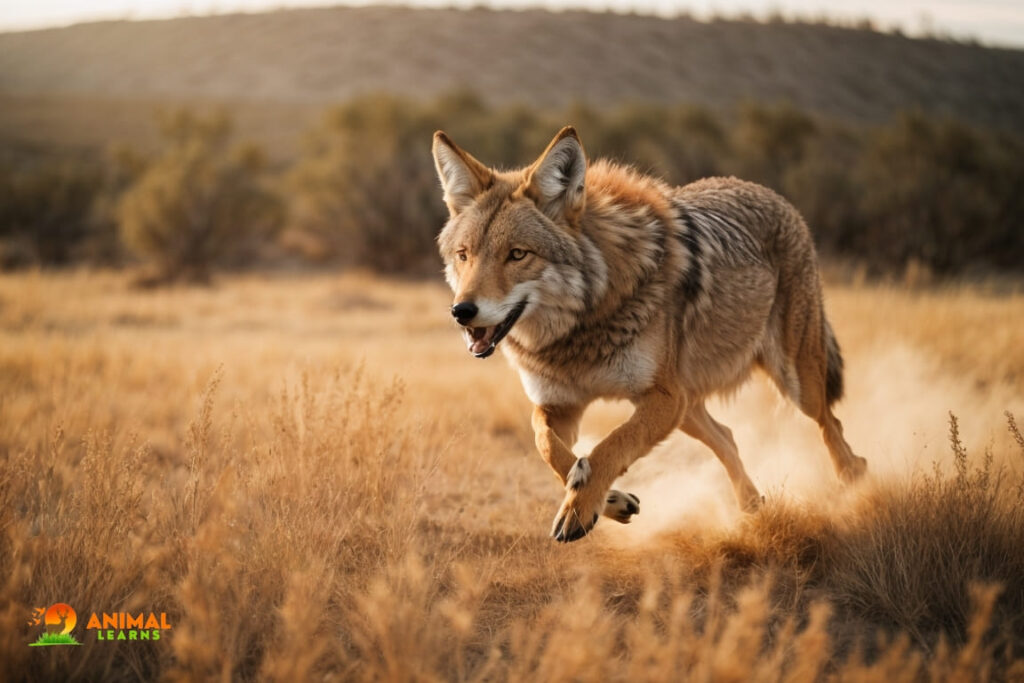
Coyotes are not inherently afraid of any specific colors. Instead, their behavior is primarily influenced by other factors, such as the presence of humans or potential threats.
Bright, contrasting colors may catch their attention, but it’s not the color itself that determines their reaction. Coyotes are naturally cautious animals and tend to avoid direct confrontations whenever possible.
What Colors Do Coyotes Not Like?
Coyotes do not necessarily have preferences for specific colors. Their hunting success primarily depends on their keen senses of smell, hearing, and vision, along with their adaptability to different environments.
They are opportunistic predators, and the color of their prey is unlikely to influence their hunting choices significantly. Instead, they rely on their ability to detect movement and spot potential prey items in various lighting conditions.
Can Coyotes See Color in Artificial Light?
Coyotes can perceive colors in artificial light, but their color vision remains limited to the spectrum they can naturally see. In artificial lighting, red and orange objects will still appear as shades of gray or brown to them.
This consistency in their color perception allows them to adapt to urban environments, where artificial lighting is prevalent, and continue their nocturnal activities effectively.
What Does Coyote Vision Look Like?
Imagine the world through a coyote’s eyes, and you’ll get a picture of a landscape with muted colors. Their vision is not as vibrant as human vision, but it’s highly attuned to motion and contrast.
Coyotes can easily spot the movement of potential prey or predators, even in low light. This ability makes them excellent hunters and helps them evade danger in the wild.
Coyote Night Vision: How Well Can They See in the Dark?
Coyotes are renowned for their exceptional night vision, a crucial adaptation for their hunting success. Their eyes are equipped with a high number of rod cells, specialized for low-light conditions. This abundance of rods enhances their ability to see well in the dark, making them proficient nocturnal hunters.
While their color vision becomes less effective in low-light situations, their keen senses of smell, hearing, and motion detection, combined with their night vision, make them formidable predators in the darkest of nights.
Coyote Photoreceptors

Coyotes are fascinating creatures with a unique visual system that sets them apart from humans. They have photoreceptor cells in their eyes that are responsible for taking in light in various wavelengths and transmitting them to the brain to form images of what they see.
However, unlike humans, coyotes have trouble seeing red light because of their photoreceptor cells. These cells are divided into two types: cone cells and rod cells.
Cone cells are responsible for color vision, while rod cells are responsible for detecting motion and contrast in low-light conditions. So, next time you see a coyote, remember that they see the world differently than we do!
Cone Cell Variation
Cone cells are the building blocks of our visual perception, allowing us to see the world in all its colorful glory. However, not all cone cells are created equal.
Different species have varying compositions and quantities of these cells, leading to unique ways of perceiving the visual world.
Humans, for instance, possess three types of cone cells: red, blue, and green. These specialized cells enable us to perceive a wide range of wavelengths, spanning from 380 to 750 nanometers, corresponding to various colors across the spectrum. The table below illustrates the wavelength ranges associated with different colors:
| Color | Wavelength Range |
| Red | 620 to 750 nm |
| Orange | 590 to 620 nm |
| Yellow | 570 to 590 nm |
| Green | 495 to 570 nm |
| Blue | 450 to 495 nm |
| Violet | 380 to 450 nm |
On the other hand, coyotes have only two types of cone cells: blue and yellow. While this dichromatic vision allows them to perceive colors within the blue and yellow range more effectively, it also imposes limitations on their ability to perceive other colors. Specifically, they struggle to discern colors with long wavelengths, such as red.
Red, with its lengthy wavelength, requires a dedicated red cone cell to be detected. The absence of this cone cell in coyotes makes it challenging for them to distinguish this color from others.
Additionally, it’s important to note that coyotes are primarily nocturnal animals, adapted for low-light conditions.
Cone cells require sufficient light to function optimally, further compromising their ability to perceive colors. In essence, coyotes’ vision is dichromatic and relatively colorblind, particularly when it comes to colors like red, which fall outside their perceptual range.
Rod Cells: Enhancing Coyote Night Vision
Coyotes have a unique ability to see in the dark, thanks to their abundance of rod cells, and specialized photoreceptors that enhance vision in dim or nocturnal conditions.
These cells are responsible for the coyote’s remarkable night vision capabilities, enabling them to navigate and hunt effectively when natural light is scarce.
However, it’s important to note that rod cells are primarily monochromatic and lack the ability to perceive color. As a result, any light captured by these photoreceptors is interpreted by the coyote as monochromatic, typically appearing as black and white or grayscale imagery.
Interestingly, this unique characteristic of coyote vision, coupled with the absence of red cone cells entirely, provides an interesting opportunity for hunters to capitalize on their otherwise impressive vision by employing red light sources to minimize detection.
Exploring the question “Are coyotes colorblind” adds an intriguing dimension to our understanding of these adaptable predators.
Are coyotes colorblind? Many people wonder about the visual abilities of these elusive creatures. So if you’re planning a coyote hunt at night, consider using red light sources to avoid detection and increase your chances of success.
Conclusion
In summary, coyotes are not colorblind but have limited color vision compared to humans. They can see shades of blue, violet, green, and yellow but cannot distinguish between red and orange.
Their exceptional night vision, combined with their other acute senses, makes them formidable hunters in low-light conditions.
While the color of their eyes may appear to change in the dark, it is their adaptability and keen senses that truly define their success as opportunistic predators in the wild.
Coyotes continue to thrive and adapt to various environments, using their unique vision and sensory abilities to navigate the challenges of their ever-changing world.
FAQs
Are coyotes completely colorblind?
No, coyotes are not completely colorblind, but they have limited color vision.
What colors can coyotes see?
Coyotes can primarily see blues and greens, but they have difficulty distinguishing reds and oranges.
Can coyotes see in the dark?
Yes, coyotes have excellent night vision, thanks to their high number of rod cells.
How do rod cells in coyotes’ eyes affect their color vision?
Rod cells dominate their vision, making it predominantly monochromatic (black and white or grayscale).
How can hunters use coyotes’ vision characteristics to their advantage?
Hunters can use red light sources to minimize detection by coyotes, as red light is less likely to spook them in low-light conditions.





